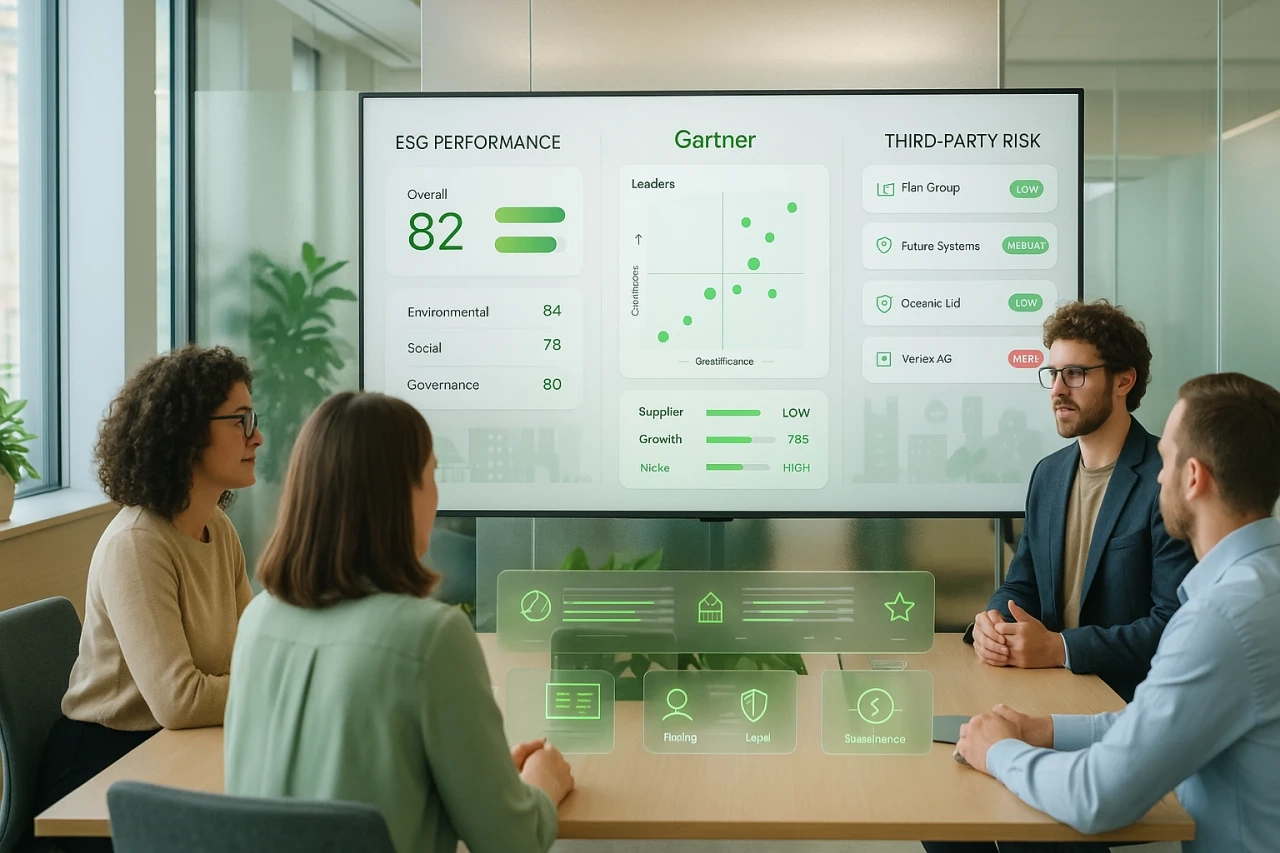Decoding Gartner Evaluation Criteria for European Third-Party Governance Platforms

As third-party governance becomes a cornerstone of operational resilience for organizations, Gartner’s Magic Quadrant evaluation standards stand out as an essential benchmark. However, their application within the European market demands a methodical adaptation to incorporate regulatory compliance with DORA, NIS 2, and CSRD, while ensuring data sovereignty and security. This dual imperative shapes how decision-makers in the public sector, industry, distribution, or construction articulate global frameworks with local expectations. This expert analysis helps organizations select the right third-party governance platforms within a demanding European regulatory landscape.
Gartner Framework: A Structural Guide for Third-Party Governance
Gartner’s evaluation matrix adopts both a technical and organizational lens to assess third-party risk management (TPRM) platforms. It emphasizes functional maturity, automation, IT integration, and industry coverage, according to recent Gartner insights on the TPRM market. However, European adoption requires strong contextualization—particularly to uphold data sovereignty and regulate cross-border data flows.
Customizing this structure means aligning collaborative assessments with enhanced criteria for security and confidentiality, ensuring compliance with regulations such as DORA and NIS 2. This methodology empowers organizations to develop effective third-party governance tailored to Europe’s specificities.
Key European Adaptation Criteria
Functional maturity
end-to-end third-party lifecycle management, risk analysis and quantification, advanced automation
Regulatory and industry coverage
compliance with DORA, NIS 2, CSRD, and national standards
Data security and confidentiality
sovereign hosting, encryption, full auditability

IT integration capabilities and adaptability to local partner ecosystems
Automation and real-time monitoring tools
How Gartner Criteria Support Risk Evaluation and Mitigation in Europe
Gartner’s criteria prioritize automation, supply chain visibility, and the ability to drive regulatory compliance. However, each requirement must be weighed according to the sector and location. In social housing, documentation robustness and traceability are key for public procurement compliance. In industry and construction—often involving non-European third parties—supply chain mapping and regulatory alert management (ICPE, construction certifications) take precedence.
This nuanced approach to risk identification and categorization ensures that third-party governance addresses real sector challenges, while remaining agile amid Europe’s fast-changing regulations. Sector-specific adaptation becomes a major differentiator for optimizing third-party risk evaluations. Within this logic, automation is key to minimizing third-party burden and mitigating supplier fatigue.
Automation, Reporting & Collaboration: Tools to Reduce Supplier Fatigue
Automation plays a crucial role in limiting excessive requests to third parties and alleviating supplier fatigue. A platform equipped with automated tracking tools ensures seamless compliance communication and efficient document collection—while respecting each actor’s digital rights.
A TPRM platform must include key features such as intelligent workflows tailored to risk profiles, automated document collection, and real-time alert systems. This approach reduces administrative tasks by 45%, according to Gartner.
Robust reporting capabilities are equally essential. Collaborative dashboards allow cross-functional oversight—from compliance heads to operational managers. The detail level of collected data, along with DORA or NIS 2-compliant reporting, provides valuable insights for audit readiness. This model aligns with automated due diligence strategies aimed at maximizing operational efficiency.
Want to see how a TPRM platform can transform your
third-party management?
Explore our Aprovall360 solution with collaborative evaluation features built for Europe.
Risk Analysis and Data Security: Aligning with European Sovereignty
Controlling data security and confidentiality is central to the Gartner framework. For European platforms, this means sovereign hosting, robust encryption, and strict access policies aligned with GDPR and sovereignty expectations. Risk identification and categorization processes must also account for third-party types—whether local microbusinesses, public institutions, or foreign industrial subcontractors.
This tailored approach adapts assessment metrics to sector-specific needs. In industry, critical vendor assessments include heightened cybersecurity requirements to protect sensitive infrastructure—illustrated by TELT’s experience managing 4,500 partners. In the public sector, priorities include document traceability and procurement compliance to ensure third-party transparency.
Flexible indicators support informed decision-making and strategic communication. This granular approach enables organizations to adapt evaluations to business needs. To implement this, Gartner methods must be translated into operational strategies that uphold European digital sovereignty and new DORA and NIS 2 obligations.
Translating Gartner to Fit the European Regulatory Landscape
While Gartner’s methodology is robust, it only delivers value if adapted to European digital sovereignty and new DORA and NIS 2 mandates. This demands focus on data processing localization, incident response, and integration with public or industrial platforms, as outlined by ENISA recommendations.
Strategic adaptation includes: built-in GDPR compliance, sector-specific document evolution, automated partner status checks, and secure interconnection with business systems. This ensures third-party supervision while meeting European regulatory constraints.
Priority Adaptation Criteria
Strict GDPR compliance, with data flows confined to the EU
Scalable documentation aligned with sector demands
Automated certification and status monitoring

Secure API integrations with business information systems
Aprovall’s experience with 450,000 third parties worldwide provides a proven foundation for effective third-party governance in Europe.
Social Housing: Granularity, Consent & Compliance Trajectory
In social housing, the Gartner grid values granular third-party management, consent tracking, and top-tier traceability. Platforms must offer interfaces tailored to stakeholders—property managers, developers, nonprofit partners—and support automated controls and shared validation of documents, while anticipating regulatory deadlines.
This enables streamlined contracting and alignment with the sector’s growing compliance burdens, as shown by France Loire’s success achieving 90% third-party compliance. Aprovall’s deep sector expertise underscores the value of third-party governance tailored to public service contexts.
Construction, Industry, Retail: Modularity and Emerging Threat Mitigation
In construction, certification compliance requires customizable workflows and dynamic alerts—as seen in our case study on construction document management. Quick adaptation to new frameworks and regulations is a key evaluation factor for Gartner-aligned platforms.
In industry and retail, collaborative assessment across the partner chain anticipates vulnerabilities—whether tied to ICPE rules or expanding marketplaces. Continuous partner feedback integration supports resilience amid supply chain disruptions and cyber threats.
This sector-specific strategy is built on Aprovall’s experience with 450,000 global partners, enabling a tailored cybersecurity benchmarking framework for each sector’s unique challenges.
Objective Metrics & Future Outlook: Toward Reference Framework Convergence
Aprovall’s position in objective comparisons using Gartner metrics shows the need for thoughtful arbitration between global standards and European realities. True value in third-party governance lies in accurately quantifying exposures and shaping improvement plans rooted in sector and regional specifics.
Combining automation tools, monitoring, and custom reporting turns compliance from a burden into a lever for long-term operational resilience. The Gartner Magic Quadrant values completeness of vision and execution capability. In Europe, these must be localized for relevant third-party platform assessments. This evolution is guided by real-world feedback and the fast-growing European TPRM market—forecast to grow from €5.6B to €17.2B by 2030.
The challenge: stay agile to integrate new regulatory shifts while ensuring peak security and confidentiality per DORA and European sovereignty standards.
This methodological transformation reflects Aprovall’s commitment to automated due diligence that complements human expertise while maximizing operational performance.
Ready to position your organization in this fast-moving market?
Discover how our experts can guide your platform selection and deployment to meet your European governance challenges.
These articles might interest you
-
 12 May 2025Understanding the Impact of the NIS 2 Directive on the Supply ChainSecteurThe modern supply chain forms the backbone of European economies, orchestrating complex flows between partners, suppliers, and subcontractors. With the acceleration of digitalization, this growing interconnection exposes organizations to unprecedented cyber vulnerabilities. The NIS 2 directive, effective since October 2024, is revolutionizing the cybersecurity approach by mandating collaborative evaluation of third-party partners. This regulatory shift […]
12 May 2025Understanding the Impact of the NIS 2 Directive on the Supply ChainSecteurThe modern supply chain forms the backbone of European economies, orchestrating complex flows between partners, suppliers, and subcontractors. With the acceleration of digitalization, this growing interconnection exposes organizations to unprecedented cyber vulnerabilities. The NIS 2 directive, effective since October 2024, is revolutionizing the cybersecurity approach by mandating collaborative evaluation of third-party partners. This regulatory shift […]Read more
-
 14 May 2025Environmental Criteria for Third-Party Partner EvaluationSecteurMore and more companies are incorporating environmental preservation into their overall strategy. Whether through sustainable practices or compliance with the CSRD (Corporate Sustainability Reporting Directive), these organizations aim to reduce their ecological footprint. The evaluation of suppliers plays a crucial role in this process, using various environmental criteria to ensure a responsible supply chain. What […]
14 May 2025Environmental Criteria for Third-Party Partner EvaluationSecteurMore and more companies are incorporating environmental preservation into their overall strategy. Whether through sustainable practices or compliance with the CSRD (Corporate Sustainability Reporting Directive), these organizations aim to reduce their ecological footprint. The evaluation of suppliers plays a crucial role in this process, using various environmental criteria to ensure a responsible supply chain. What […]Read more
-
 19 June 2025Scope 3 Data Collection Methodology: Structuring Third-Party Governance for CSRD ComplianceSecteurThe transition toward robust environmental reporting, particularly under the CSRD framework, requires both public and private organizations to thoroughly evaluate their indirect emissions, also known as Scope 3. This obligation goes far beyond regulatory compliance. In public housing, government procurement, industrial or retail sectors, the ability to structure solid third-party governance is now critical to the overall performance of an […]
19 June 2025Scope 3 Data Collection Methodology: Structuring Third-Party Governance for CSRD ComplianceSecteurThe transition toward robust environmental reporting, particularly under the CSRD framework, requires both public and private organizations to thoroughly evaluate their indirect emissions, also known as Scope 3. This obligation goes far beyond regulatory compliance. In public housing, government procurement, industrial or retail sectors, the ability to structure solid third-party governance is now critical to the overall performance of an […]Read more
-
 23 June 2025How to Select Priority KPIs or KRIs for Third-Party MonitoringSecteurIn third-party governance, tracking key performance indicators (KPIs) has become a central component in meeting rising expectations for operational resilience. Operations managers and compliance officers now expect dynamic dashboards that clearly rank the risks associated with each third-party partner while taking into account industry specifics and risk profiles. According to a Grant Thornton study, only 45% […]
23 June 2025How to Select Priority KPIs or KRIs for Third-Party MonitoringSecteurIn third-party governance, tracking key performance indicators (KPIs) has become a central component in meeting rising expectations for operational resilience. Operations managers and compliance officers now expect dynamic dashboards that clearly rank the risks associated with each third-party partner while taking into account industry specifics and risk profiles. According to a Grant Thornton study, only 45% […]Read more



